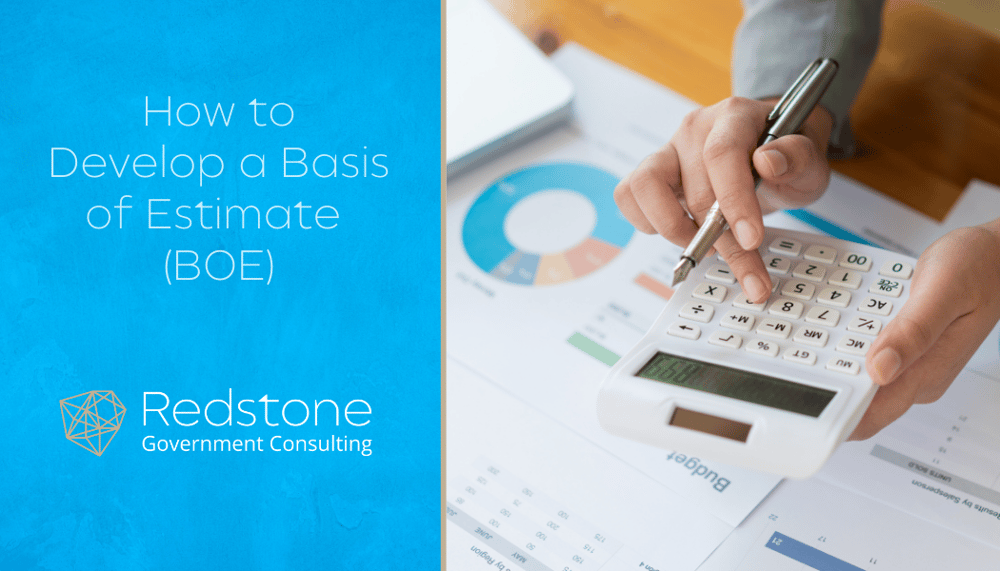
One of the most important parts of a proper response to a Government Solicitation is the Basis of Estimate(s) (BOE). The BOE is a tool that is carefully developed by members of a project team through intricate analysis of the Performance Work Statement (PWS) in order to calculate the total price for the required effort. The BOE must be developed before the pricing can take place so that the pricing team knows the cost elements, which will require pricing. To put it differently, the BOE is an estimate developed to outline a Company’s expected staffing and solutions for the selected Government solicitation. This proposed estimate is combined with detailed explanations and supporting rationale which bolsters the overall conclusion. The BOE needs to be able to show the level of services (proposed labor), the skill mix required, materials, travel, etc., that will be required to deliver what is requested through the solicitation. In order to provide a realistic estimate, technical experts should be utilized in order to appropriately determine the work effort needed. The details in the BOE need to be sufficient for the technical evaluator (government or prime contractor) to understand the rationale used, the source of the underlying data, the detailed calculations involved, and the basis for any complexity factors.
Common Elements in a BOE
Some common elements should be included in the development of a BOE are:
- Thought process and approach (the logic behind choices made)
- Company Experience (comparison to historical data or programs)
- Time Span/Period of Performance
- Quantity estimates
- Engineering Judgement
- Mathematical Calculations
- Complexity Factors and Basis for Factors (e.g. efficiency or scrap/rework)
Presenting Your BOE
While the development of the proper BOE estimate is vital, the presentation of that estimate in the BOE narrative is just as important. There is nothing worse than putting a clever plan together, only to have the reader be unable to understand it. You will need to check your specific solicitation requirements to identify where the narrative needs to go; it is possible they could be required as a part of the Cost Volume, part of the Technical Volume, or both. Invariably, there will be a lot of numbers and calculations that take place in the BOE narrative. You have to be able to present your decisions in a way that a third party reader could follow. There are varying opinions out there about the best practice when it comes to the presentation of a BOE. In our opinion, we suggest that you outline the BOE in the following four steps. Start by identifying the PWS element that you are pricing in a bold and easily seen header. This will let the reader know what element you are estimating. Next, include a description of the BOE that you have come up with. This could describe the labor categories selected, the level of those labor categories, and what team member will be performing, among many other things. Next, you will want to present the BOE you’ve formed for the particular PWS that you identified in your header. Depending on how the solicitation is written, this can be done in a number of ways. Our recommendation is to incorporate a table into your narrative that shows all of the elements required in the development of your BOE (labor categories, hours, etc.). And finally, we recommend you tie all of this information into a concise summary that outlines your plan.
Common Mistakes in BOE Development
The development and presentation of the BOE can be a very difficult and meticulous process. There are many working parts, which need to be checked and rechecked in order to ensure that everything is reconciled. Below are three examples of mistakes that we encounter when reviewing BOEs for our clients:
- In your presentation of the BOE, you need to be sure that the numbers reconcile. The amounts represented in the BOE narrative should tie back to the pricing worksheets. Further, the math needs to be correct. Due to the fact that the BOE will be manually input into the Word version of your narrative, there is a risk for “input error.”. The numbers need to be checked several times by multiple readers to ensure they are all correct.
- Because personnel with technical expertise develop BOEs, it is common for their narratives to get into the weeds, per se. You need to make sure that any third party reader can read and comprehend the plan of action for completing the PWS requirements.
- Generally, a solicitation will have a labor category with multiple levels. It is important to justify your selection of labor category level. Ask yourself, “Did I adequately tell the reader why we selected a Level 3 instead of a Level 4 to complete the scope of work in the PWS?” You need to be able to justify why you selected a particular level and why it was best to do so.
Achieving the Final Price
After you have gone through the methodical process of developing the BOE and inputting it into the narrative format, you will be able to get to the final price; this is your ultimate goal. At Redstone GCI, we work exclusively with government contractors, and can help you in the development of your BOE, and/or the pricing and proposal of cost in order to accurately respond to a government solicitation. We would be happy to discuss with you the services and support we offer to make this process better and more effective for your next proposal.

